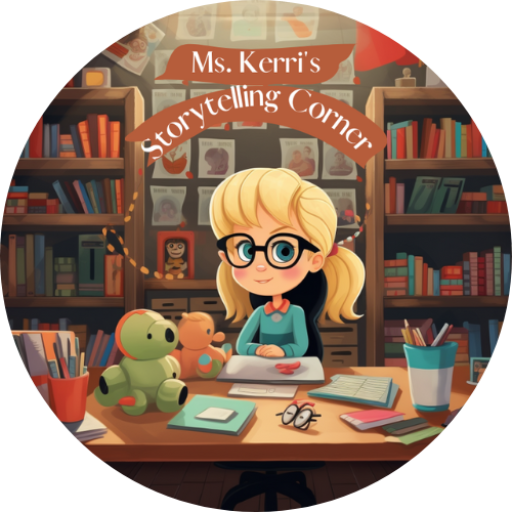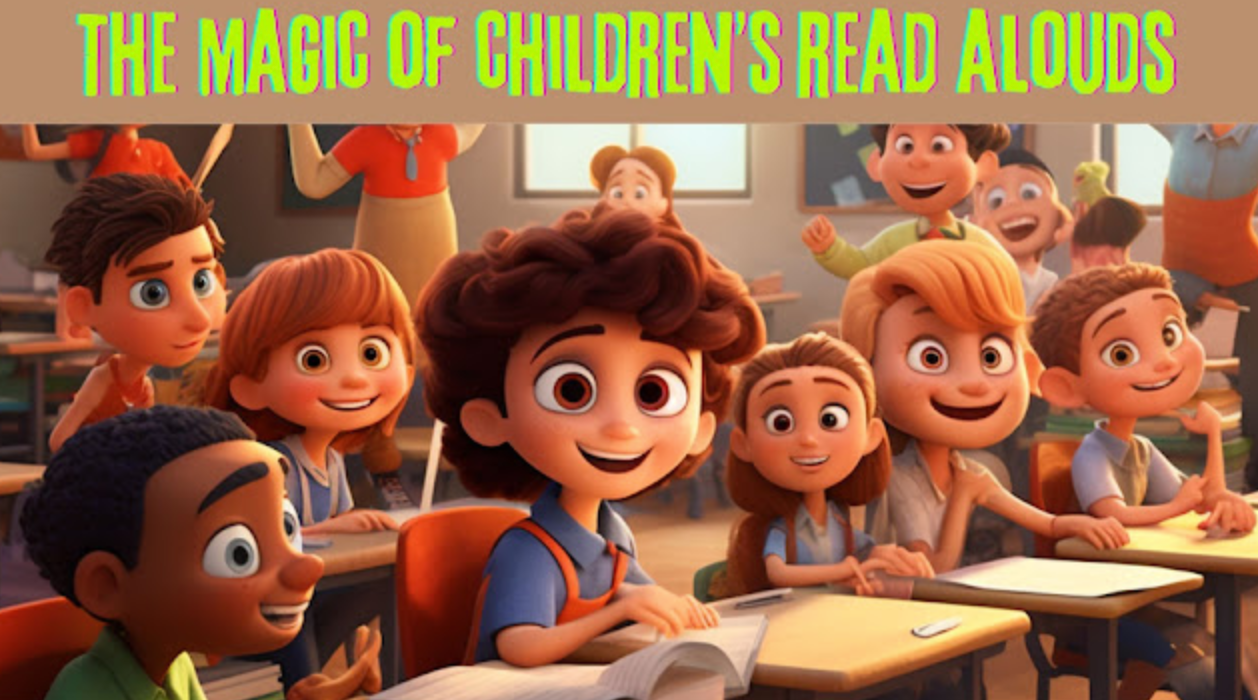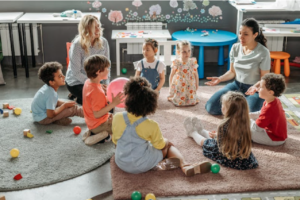Unleashing the Verbal Enchantment: Illuminating Young Minds through the Magic of Children’s Read Alouds
Storytelling is an age-old art form that has captivated audiences since the dawn of civilization. It is the act of conveying a narrative through spoken or written words, often accompanied by gestures, expressions, and vivid descriptions.
From ancient myths passed down from generation to generation to the memorable tales read aloud at bedtime, storytelling holds a special place in our collective consciousness. Throughout history, stories have transcended cultural boundaries and served as vehicles for knowledge transmission, moral teachings, and cultural preservation. They have been instrumental in shaping our understanding of the world around us while igniting our imaginations. Whether it’s the epic adventures of Odysseus or the whimsical tales of Hans Christian Andersen, stories have entertained, educated, and inspired people across civilizations. Importance of storytelling in children’s developmentFor young minds on their journey towards growth and understanding, storytelling plays a pivotal role in their cognitive and emotional development. It serves as a gateway to literacy by introducing children to the intricacies of language through engaging narratives. The enchanting power of storytelling can transport them to new realms where they encounter unknown words and phrases that expand their vocabulary. Moreover, storytelling nurtures listening skills as children eagerly hang on every word spoken by parents or teachers who bring characters to life with animated voices and expressive gestures. This practice enhances their comprehension abilities as they follow storylines and interpret meaning from context clues. In this way, storytelling acts as a foundation for reading fluency later on. However, its impact extends far beyond literacy skills alone. Storytelling also fires up children’s imaginations like fireworks on a starry night sky. Imagination is an invaluable tool that aids problem-solving abilities by allowing young ones to explore different perspectives and think creatively. Through stories, they can embark on adventures with brave heroes, solve mysteries with clever detectives, or even take a voyage beyond the stars with courageous astronauts. The possibilities are endless, and their minds become fertile grounds for growth and ingenuity. In short, storytelling is a vital ingredient in the recipe for nurturing young minds. It sparks curiosity, fosters empathy and creativity, and lays the foundation for a lifelong love of reading. So next time you find yourself lost in the pages of a captivating storybook with a child by your side, remember that you are seeding their imagination and opening doors to worlds yet to be discovered.
Click HERE for craft ideas that bring stories to life!
Enhancing Language and Literacy Skills

Vocabulary Expansion through Exposure to New Words
When children are exposed to read alouds, their vocabulary expands exponentially. Through the magical world of storytelling, they encounter a multitude of new words and phrases that might not be a part of their everyday conversations. These encounters with unfamiliar words help children broaden their linguistic repertoire and develop a rich vocabulary. The more words they hear, the greater their ability to express themselves with precision and clarity.
Development of Listening and Comprehension Skills
Read alouds also play a pivotal role in nurturing children’s listening and comprehension skills. As they listen attentively to stories, their ability to understand spoken language improves. They learn how sentences are structured, how ideas are connected, and how thoughts are conveyed. Moreover, by following the narrative thread of a story, children enhance their comprehension skills as they piece together information and make meaning from the text.
Improvement in Reading Fluency and Expression
Listening to stories being read aloud benefits not only language development but also reading fluency and expression. As young minds absorb the rhythmic patterns of sentences during read aloud sessions, it helps them internalize the natural flow of language in written texts. This exposure helps them become more fluent readers who can read smoothly with appropriate pauses for punctuation as well as varying intonation for dialogue or emphasis. Additionally, hearing stories read aloud exposes children to different writing styles and techniques that can inspire them to experiment with new ways of expressing themselves when they become confident readers.
Fostering Imagination and Creativity
Stimulating Visualization through Descriptive Language
One captivating aspect of storytelling is its ability to transport young minds into vividly imagined worlds. Through descriptive language filled with sensory details such as sights, sounds, smells, tastes, and textures, children learn to create mental images that make stories come alive in their minds. This process of visualization not only enhances their comprehension but also ignites their imagination, allowing them to visualize characters, settings, and events in intricate detail.
Encouraging Imaginative Thinking and Problem-Solving Abilities
When children immerse themselves in stories, they are exposed to a vast array of situations where characters encounter challenges or dilemmas. As they witness these fictional characters navigate through obstacles and find creative solutions, young listeners are inspired to think imaginatively and critically. Storytelling provides them with a safe space to explore different perspectives and potential solutions to problems. By observing the characters’ thought processes and decision-making skills, children develop problem-solving abilities that they can apply in their own lives.
Building Empathy and Emotional Intelligence

Identification with Story Characters’ Emotions and Experiences
One of the most powerful aspects of storytelling is its ability to evoke emotions within readers or listeners. By immersing themselves in the experiences of the story’s characters, children build empathy as they understand different emotions such as happiness, sadness, fear, or excitement. Through this emotional connection with the characters’ journeys, young minds learn how to recognize and empathize with others’ feelings beyond their own limited experiences.
Understanding Diverse Perspectives and Cultures
Stories provide windows into diverse worlds by introducing children to different cultures, traditions, values, and perspectives. When children encounter stories that depict individuals from various backgrounds or situations dissimilar from their own lives, it broadens their understanding of the world around them. They gain insights into different ways of life while learning about empathy towards individuals who may have contrasting beliefs or experiences. These encounters cultivate cultural sensitivity within young minds by fostering an appreciation for diversity while nurturing a sense of inclusion and acceptance. Through read alouds, children not only enhance their language and literacy skills but also embark on a journey of imagination, empathy, and understanding. The power of storytelling lies in its ability to shape young minds by nurturing their linguistic abilities, fostering creativity, and cultivating emotional intelligence. As we delve deeper into the science behind this enchanting process in the following sections, we will uncover more reasons why read alouds are an invaluable tool for shaping young minds.
The Science Behind the Magic: How Storytelling Impacts the Brain
Activation of multiple brain regions during storytelling sessions
When a captivating story unfolds, it is not just our imagination that is stimulated. Our brains come alive as well. Research has shown that storytelling activates various regions in the brain simultaneously, creating a symphony of activity. As we listen to or read stories, our language processing areas light up in response to the words and sentences, allowing us to comprehend and make sense of the narrative. This engagement of language processing areas is crucial for children’s comprehension skills, as they learn new vocabulary and sentence structures.
Engagement of language processing areas for comprehension
Storytelling isn’t just about passively consuming words; it requires active engagement with language. When children listen to or read stories, their brains are working hard to process the meaning behind each word and sentence. Language processing areas such as Broca’s area and Wernicke’s area are activated, enabling children to understand the narrative at a deeper level. By immersing themselves in well-crafted stories, young minds become skilled at decoding meanings from context clues, improving their overall reading comprehension abilities.
Stimulation of sensory areas for visualization
Have you ever found yourself envisioning vivid scenes while reading a story? That’s because storytelling activates sensory areas in our brains responsible for visualization. When children hear descriptive language that paints pictures in their minds, regions such as the occipital lobe (responsible for visual processing) light up with activity. This stimulation helps children develop their ability to create mental images from written or spoken words, enhancing their imaginative thinking skills.
Impact on neurological development
The impact of storytelling on neurological development cannot be overstated. The engaging nature of narratives enhances neural connections related to language acquisition in children’s developing brains. As they listen to stories and follow the narrative structure, their neural pathways responsible for language processing and comprehension become stronger. This strengthening of connections facilitates not only their ability to understand stories but also their overall language development. Moreover, storytelling helps strengthen memory formation in children through its narrative structure. When information is presented in a story format, it becomes easier for young minds to remember and recall details, fostering long-term memory retention. By understanding the science behind storytelling’s impact on the brain, we can fully appreciate its power as an educational tool and a means of cognitive development for young minds. The activation of multiple brain regions during storytelling sessions, engagement of language processing areas for comprehension, stimulation of sensory areas for visualization, and the resulting impact on neurological development all contribute to shaping young minds in profound ways. So next time you settle down with a child to read aloud a captivating tale, remember that you are not just entertaining them; you are igniting their brains and molding their cognitive abilities through the magic of storytelling.
The Role of Storytelling in Socialization

Creating a shared experience between the reader/storyteller and child listener
Imagine snuggling up on a cozy couch with your little one, holding a beautifully illustrated book in your hands. As you begin to read aloud, the words on the page come alive, transporting both of you to magical worlds and captivating adventures. In this moment, you are not just reading a story; you are creating a shared experience that will forever be etched in both your hearts. The act of storytelling allows for a unique connection between the reader/storyteller and the child listener. Through read alouds, parents or caregivers have an opportunity to engage with their children on an intimate level. The gentle tone of their voice, the animated facial expressions, and the physical closeness all contribute to building an emotional bond that extends beyond the pages of a book. The child feels safe and nurtured by this shared experience as they are fully immersed in the narrative alongside their caregiver. This sense of connection fosters trust and deepens their relationship, leaving lasting imprints on both their minds and hearts.
Promoting bonding, trust, and emotional connection
Storytelling not only creates shared experiences but also acts as a powerful catalyst for bonding between parents or caregivers and children. Sharing stories together builds trust as children rely on their loved ones to guide them through unfamiliar narratives or difficult emotions presented in literature. They learn that they can lean on their trusted adult when encountering challenging situations depicted in stories. Moreover, storytelling ignites an emotional connection that goes beyond words alone. It provides an opportunity for children to explore complex emotions through fictional characters’ experiences, allowing them to develop empathy and understanding. As parents or caregivers discuss these emotions with their little ones during read alouds or afterward, they deepen their emotional connection further by validating feelings and providing comfort. These shared emotional journeys through storytelling lay the foundation for open communication, fostering strong bonds of love and support between adults and children.
Encouraging social interaction through discussions about stories
Storytelling goes beyond the intimate bond between a reader/storyteller and a child listener; it also opens up avenues for social interaction and dialogue. After reading a story, parents or caregivers can engage their children in discussions, asking questions that encourage critical thinking and reflection. These conversations not only deepen comprehension but also provide an opportunity for children to express their thoughts, opinions, and ideas. Through discussing stories together, children learn to articulate their feelings and perspectives while simultaneously developing important communication skills. They become active participants in the narrative as they share their interpretations of events or predict possible outcomes. Additionally, engaging in story-related conversations helps build social skills as children learn to listen attentively, take turns speaking, and respect differing viewpoints. Storytelling plays a pivotal role in socialization by creating shared experiences between the reader/storyteller and child listener that foster bonding, trust, and emotional connection. Moreover, it encourages meaningful social interactions through post-story discussions where children can express themselves while developing critical thinking skills. By embracing the power of storytelling as a tool for socialization, we can shape young minds by nurturing strong relationships and facilitating open communication within our communities.
The Power of Representation: Diversity in Children’s Literature
Embracing the Kaleidoscope of Characters, Cultures, and Experiences
Children’s literature has the extraordinary ability to shape young minds by offering a window into a world beyond their own immediate experiences. By incorporating diverse characters, cultures, and experiences, children’s books serve as powerful tools for fostering empathy, understanding, and acceptance. When children are exposed to stories that reflect the rich tapestry of humanity, they learn that the world is not homogenous but rather beautifully diverse. Diversity in literature goes beyond mere tokenism; it is about authentically representing various ethnicities, races, religions, abilities, genders, and socioeconomic backgrounds. By featuring protagonists from different walks of life and introducing readers to unfamiliar customs and traditions, these stories broaden children’s perspectives and help them develop a genuine appreciation for cultural differences. When young readers see themselves reflected in the pages of a book or encounter characters who look or live differently from them but share common emotions and aspirations, they are more likely to cultivate a sense of belonging and inclusion.
Nurturing Self-Esteem: The Impact on Identity Formation
Representation matters because it directly contributes to a child’s self-esteem and identity formation. When children encounter characters who resemble their own identities or share similar experiences in books that celebrate their culture or background positively—whether it’s race, religion or disability—they feel seen and validated. This validation helps them develop a sense of pride in who they are while instilling confidence in their abilities. Inclusion in literature also provides an opportunity for children from marginalized communities to see themselves as heroes with agency within narratives. It allows them to imagine possibilities beyond societal stereotypes or limitations placed on them by others. When young readers find stories where people like them take center stage as protagonists navigating adventures or overcoming challenges with strength and resilience—uplifting their communities in the process—they begin to believe that they too can accomplish great things. By promoting diverse representation, children’s literature becomes a catalyst for empowering young minds to embrace their unique identities and aspirations.
Breaking Stereotypes: The Role of Inclusive Storytelling
Inclusive storytelling offers a powerful antidote to stereotypes by challenging preconceived notions and providing nuanced portrayals of characters. It allows authors and illustrators to break free from limiting archetypes and instead present diverse individuals with complex identities, personalities, and aspirations. By deconstructing stereotypes through literature, children learn that people should never be reduced to simplistic labels or predefined roles based on their background. Through thoughtful storytelling, children’s books can tackle sensitive topics such as racism, prejudice, and discrimination in an age-appropriate manner while promoting empathy and understanding. These stories encourage critical thinking by inviting young readers to reflect on their own biases and question societal norms. As children engage with narratives that dismantle stereotypes, they develop the skills required for navigating a diverse world with empathy, respect, and open-mindedness. By embracing diversity in children’s literature and ensuring representation is authentic and inclusive, we empower young readers to become compassionate individuals who celebrate differences rather than fear them. Through these stories, children are not merely entertained but are provided with invaluable tools for shaping a better future – one where acceptance thrives amidst the beauty of our collective human experience.
Choosing the Right Books: Factors to Consider
The Power of Representation: Diverse Characters and Cultures
When selecting books for read alouds, it is vital to consider the power of representation. Look for books that feature diverse characters from different cultures, backgrounds, and experiences. By exposing children to a range of perspectives, they develop a broader understanding of the world and cultivate empathy towards others. Seek out stories that celebrate diversity and challenge stereotypes, allowing children to see themselves reflected in the characters they encounter.

The Wonder of Storytelling: Engaging Plots and Imaginative Illustrations
Engaging storytelling is key when choosing books for read alouds. Look for captivating plots that capture children’s imaginations and leave them eager to discover what happens next. Whether it’s an enthralling adventure or a heartfelt tale, stories that hold their attention will create lasting memories. Additionally, consider books with vibrant illustrations that complement the narrative. Imaginative imagery can enhance the reading experience by bringing the story to life through visual appeal.
Conclusion
As we have explored the power of storytelling in shaping young minds through read alouds, it becomes evident that this age-old tradition has immeasurable benefits for children’s development. From enhancing language skills and nurturing creativity to fostering empathy and building social connections, storytelling holds immense potential. By actively selecting books that feature diverse characters and cultures, we ensure an inclusive representation that celebrates differences while encouraging acceptance and understanding among young readers. Moreover, engaging plots paired with imaginative illustrations captivate children’s hearts and minds. So let us continue on this journey of storytelling with optimism—knowing that every read aloud session offers an opportunity for growth, connection, and transformation in the lives of our young ones. With each word spoken or page turned, we ignite curiosity, fuel imagination, and instill lifelong love for the written word.


Ms. Kerri’s Corner provides a exciting virtual space for preschool learning. Through a variety of engaging activities, she exposes young minds to early math, literacy, science and social-emotional skills in a developmentally appropriate way. Centers for blocks, art, books and music allow children to explore hands-on learning at their own pace. Guided lessons subtly introduce number sense, letter sounds and narrative thinking. Careful observation gives insight into each child’s progress across domains. Viewers are also invited to participate, reinforcing that their ideas are valued. By making learning fun yet purposeful, Ms. Kerri lays the groundwork for future academic success while fostering creativity and imagination. Her program offers preschoolers valuable screen-based learning experiences.




